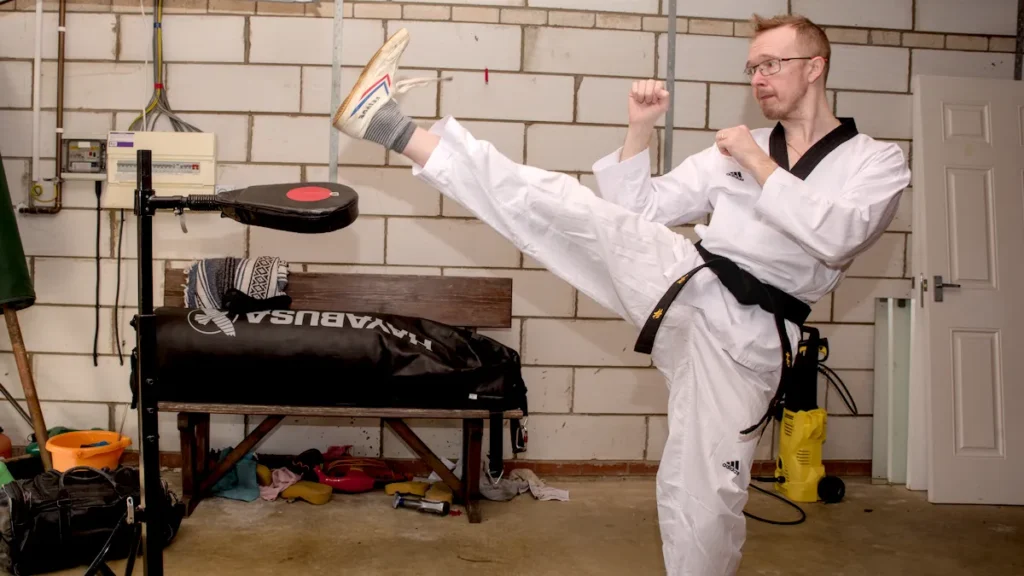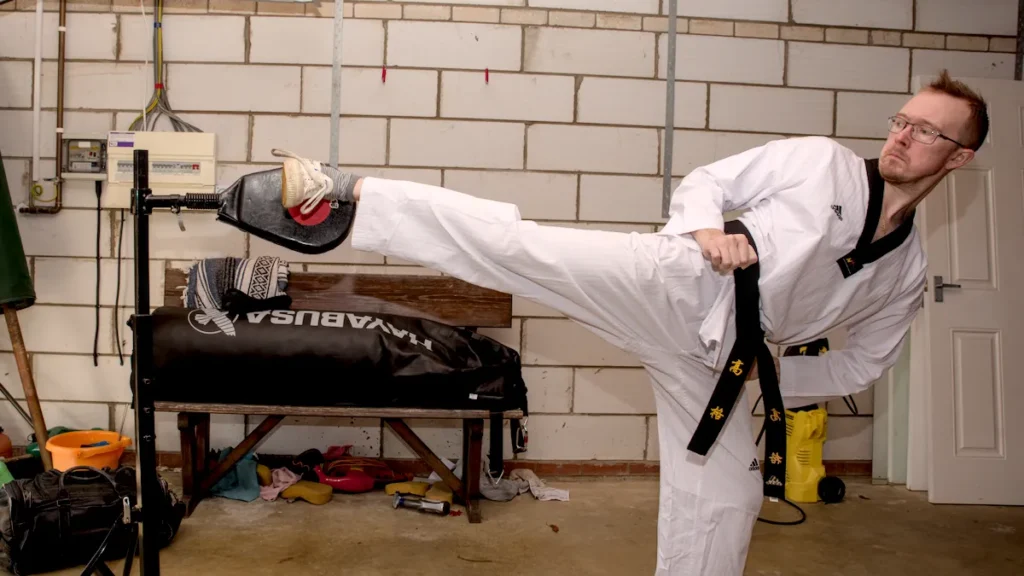You’ve found this page because you want to know all the taekwondo kicks with their Korean names. You’re in the right place. I became a Taekwondo black belt over 20 years ago and created this list with explanations for every taekwondo kick so you could learn them at home.
Taekwondo Kicks With Their Korean Names
| English | Korean | Pronunciation |
|---|---|---|
| Front Kick | 압차기 | ap cha gi |
| Turning Kick, Roundhouse | 돌려차기 | dol ryeo cha gi |
| Side Kick | 옆차기 | yeop cha gi |
| Axe Kick | 도끼차기 | do kki cha gi |
| Push Kick | 밀어차기 | mil eo cha gi |
| Back Kick | 뒤축차기 | dwi chuk cha gi |
| Hook Kick | 후크차기 | hu ku cha gi |
| Spinning Heel Kick | 반대 돌려 차기 | ban dai dol ryeo cha gi |
| Crescent Kick | 반달차기 | ban dal cha gi |
| Butterfly Kick | 나비차기 | na bi cha gi |
| Double Kick | 이중차기 | i jung cha gi |
| Dragon Kick | 용차기 | yong cha gi |
| Whip Kick | 채찍질차기 | chae jik jil cha gi |
Front Kick

The taekwondo front kick is performed by lifting the knee of the back leg and then extending the leg with the foot stretched forward and the toes pulled back. The front kick is snapped back after contact, so avoid pushing with it or use the push kick found below.
You use the ball of your foot to make contact when you use the front kick. In competition, the target for your front kick will be the body or head. In self-defense, however, the front kick can be targeted at the groin, gut, solar plexus, chin, or face.
Variations of the Taekwondo Front Kick
- Jumping front kick
- Scissor Kick
- Front Leg front kick
- Skipping font kick
45-Degree Turning Kick

The 45-degree turning kick is a variation of the turning kick below, but it is so useful and common that it deserves its own explanation. Many people who think they are throwing a turning kick are actually throwing a 45 because they don’t turn their hips over enough (possibly due to flexibility issues.)
It’s halfway between a front kick and a turning kick. Start by raising your knee like a front kick, but the standing foot is turned about 90 degrees to allow the hips to turn over slightly. Then, when the kick is extended, the leg will not move straight up like a front kick. Instead, it will be at a 45-degree angle.
There’s no need to pull the toes back for this kick. Instead, use the shin or top of the foot to make contact.
This kick is faster than a full-turning kick but not as powerful. It allows access to targets the front kick cannot hit, such as the sides of the body, without the total commitment of throwing a turning kick. The main target of the 45 is the body, as throwing a 45 to the head can be awkward, depending on your flexibility.
Variations of the 45 Degree Turning Kick
- Skipping 45
- Double 45
- 180 45 (tornado kick)
Turning Kick or Roundhouse Kick

The turning kick is a powerhouse. You’ll see it in taekwondo competitions, other martial arts, and even in the UFC. If you’re looking to knock out your opponent, this is a kick you need to know.
It’s performed similarly to the 45 above, except the standing foot turns a full 180 degrees to face behind you, which allows the hips to fully turn over and for the kick to travel parallel with the ground.
The turning kick is a heavy kick that you can load up with power, but it is a little slower than throwing a front kick or 45. Following this kick, you will be vulnerable for a moment while you regain your balance and stance. Some fighters will spin around if they miss the kick to regain their fighting stance.
Variations of the Turning Kick
- Double turning kick
- Low-high turning kick
- Front leg turning kick
- Skipping turning kick
Side Kick

After that scene in Way of the Dragon where Bruce Lee side-kicks someone into a pile of boxes, the skip sidekick became the coolest kick you could do. Unfortunately, it’s not seen much in modern MMA training or the UFC, except occasionally for kicking the knees.
Here’s how to do the sidekick:
- Lift the knee of the back foot.
- Turn the hips over, cocking the leg, and flexing the foot.
- Extend the leg and strike with the heel.
Some taekwondo schools may teach you to hit with the blade of the foot (outer edge), but that can lead to injury. Striking with the heel is not only safer but also delivers more power.
It’s a mistake to think of the sidekick as merely a pushing kick turned sideways (although it can be.) Look at the clip below and see how Bruce performed this kick in Way of the Dragon. There is no push there. He makes contact at the end of the kick; you can think of the side kick as the leg equivalent of a right hand in boxing.
Variations of the Side kick
- Flying side kick
- Skipping side kick
- Front leg side kick
- Spinning side kick
Axe Kick

When I was a boy, a woman in our taekwondo club threw up after someone threw an axe kick too close to her head – true story!
The axe kick is another kick you don’t see much outside of taekwondo competition. It isn’t necessarily ineffective; it’s just that most styles don’t teach it.
There are two ways to perform this head-splitting technique.
The first is to raise your straight leg as high as possible and then let it come down with the foot flexed, using the heel to strike downwards; anything it hits will take damage. You may need to move inward or outward in a slight arc to make this kick work.
The second method starts like a front kick, with the leg going up bent, the straightened at the top, and chopping in the same way as the straight leg variation. This one won’t be as powerful, but it’s easier to land, and you can do it even when the opponent is close.
Variations of the Axe Kick
- Skipping axe kick
- Front leg axe kick
Push Kick

The push kick is something everyone must learn. It’s great for pushing back the opponent and creating space for a power kick. Sometimes, a single pushkick may be enough to put an opponent on the ground.
This kick looks a little like a front kick, but instead of only lifting the knee up, it goes up, and then you pull it in toward your chest. Flex the foot as you push the leg out so you hit with the flat of your foot and can push your opponent away. If you have a large kick shield, this is a great one to practice.
Variations of the Push Kick
- Front leg push kick
- Running push kick
Back Kick

The back kick is primarily a counter kick. It’s great when an opponent is moving forward to attack. Instead of getting hit, you quickly turn and return fire with this heavy kick to the body. Use the right leg, and this kick will often land on the liver and will stop a fight immediately.
Here’s how to do a back kick:
- Turn on the balls of both feet so you face the opposite direction.
- Look over your shoulder to spot the target
- Lift the original back leg
- Push the heel hard toward the target.
This kick will take some time to master and might initially feel awkward. Practice it with both legs and try the much faster jumping variation when you’ve got it down.
Variations of the Back Kick
- Jumping back kick
- Spinning side kick
Hook Kick

The hook kick is an interesting one. It’s almost always thrown at the head and is an excellent way to get around a guard with high hands.
The simplest way to explain it is to do a high side kick that misses the opponent, then bend the leg and strike with the heel. You’ll have to try this one and get a feel for it. While it’s not a kick you’ll use often, it’s a good one to have in your arsenal. You’ll see Connor Mcgregor throw this kick in the first seconds of his first fight with Dustin Poirier in UFC 178.
Spinning Heel Kick

The spinning turning kick, dragon’s tail, and spinning heel kick-this kick has many names. Whatever you call it, there’s no denying this is possibly the most potent kick you can throw. Even partial contact with this kick can result in a knockout. I was once knocked out by this kick in a taekwondo competition sometime in the late 90s.
Thankfully, my head has cleared since then, so here’s how to perform the spinning heel kick.
- Start by turning your feet like the start of a back kick
- But instead of bending the back leg, you keep it straight
- Bend at the waist and keep spinning
- As your foot approaches the target, use your hips to push through the target and finally bend at the knee.
Variations of the Spinning Heel Kick
- 540 Jumping spinning heel kick
Crescent Kick

In some ways, the crescent kick looks similar to an axe kick, but it’s a very different technique in practice.
The axe kick is a chopping motion where you strike on the way down; the crescent kick uses the inside or outside of the foot and strikes coming across.
You don’t see crescent kicks much in competition, and they can damage your knee if you hit something too hard. Still, it’s a good kick to know, and your opponent won’t see it coming!
Variations of the Crescent Kick
- Inside crescent kick
- Outside crescent kick
Twisting Kick

The twisting kick is an odd movement. It’s not something that you will see in competition, and most practitioners don’t even practice it. Some may have never heard it even existed.
The simplest way to explain this odd kick is a turning kick, where you turn the wrong way. So, if you kick with the right foot, you turn to the right. Don’t expect to get much power with this one!






